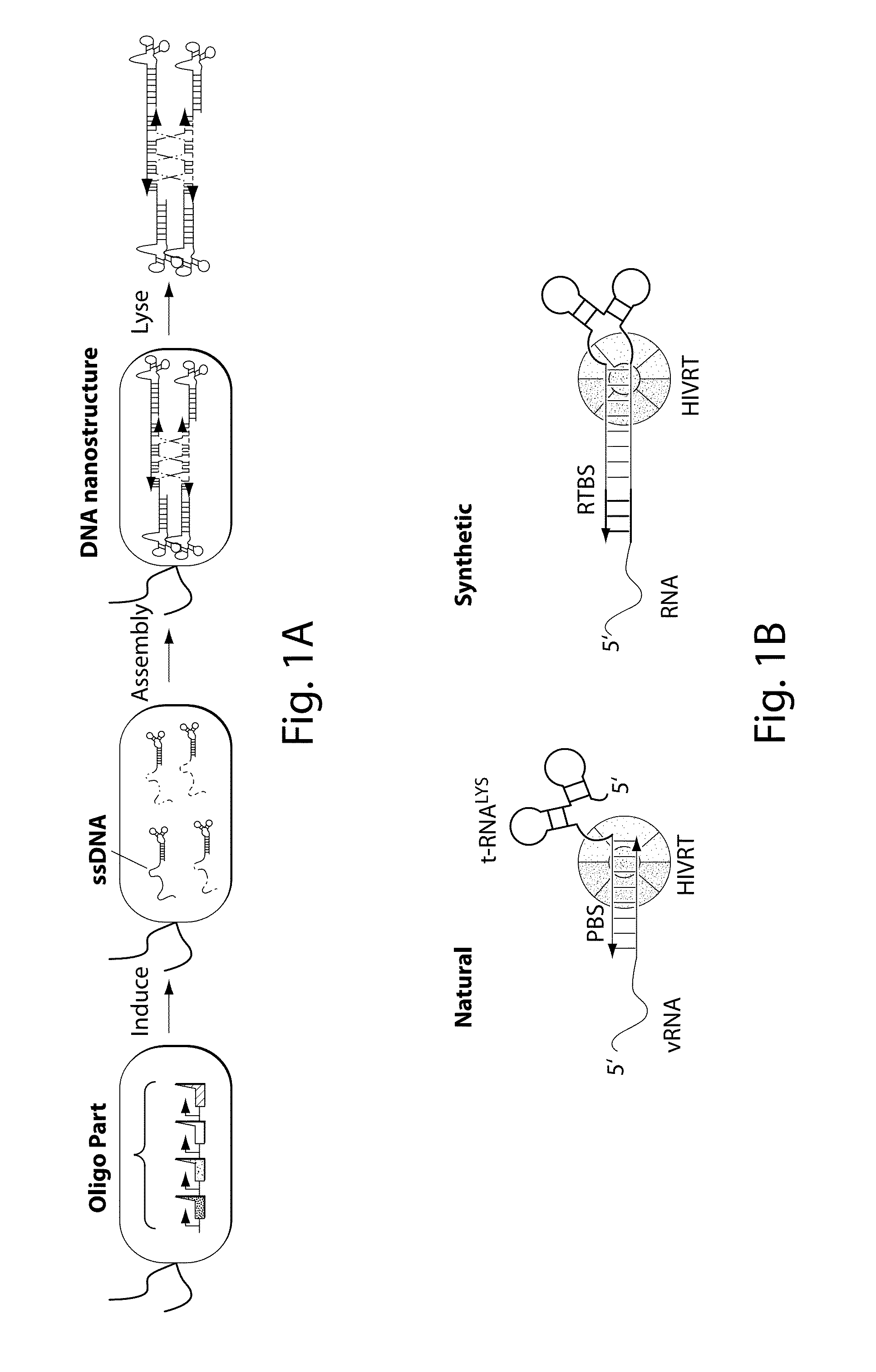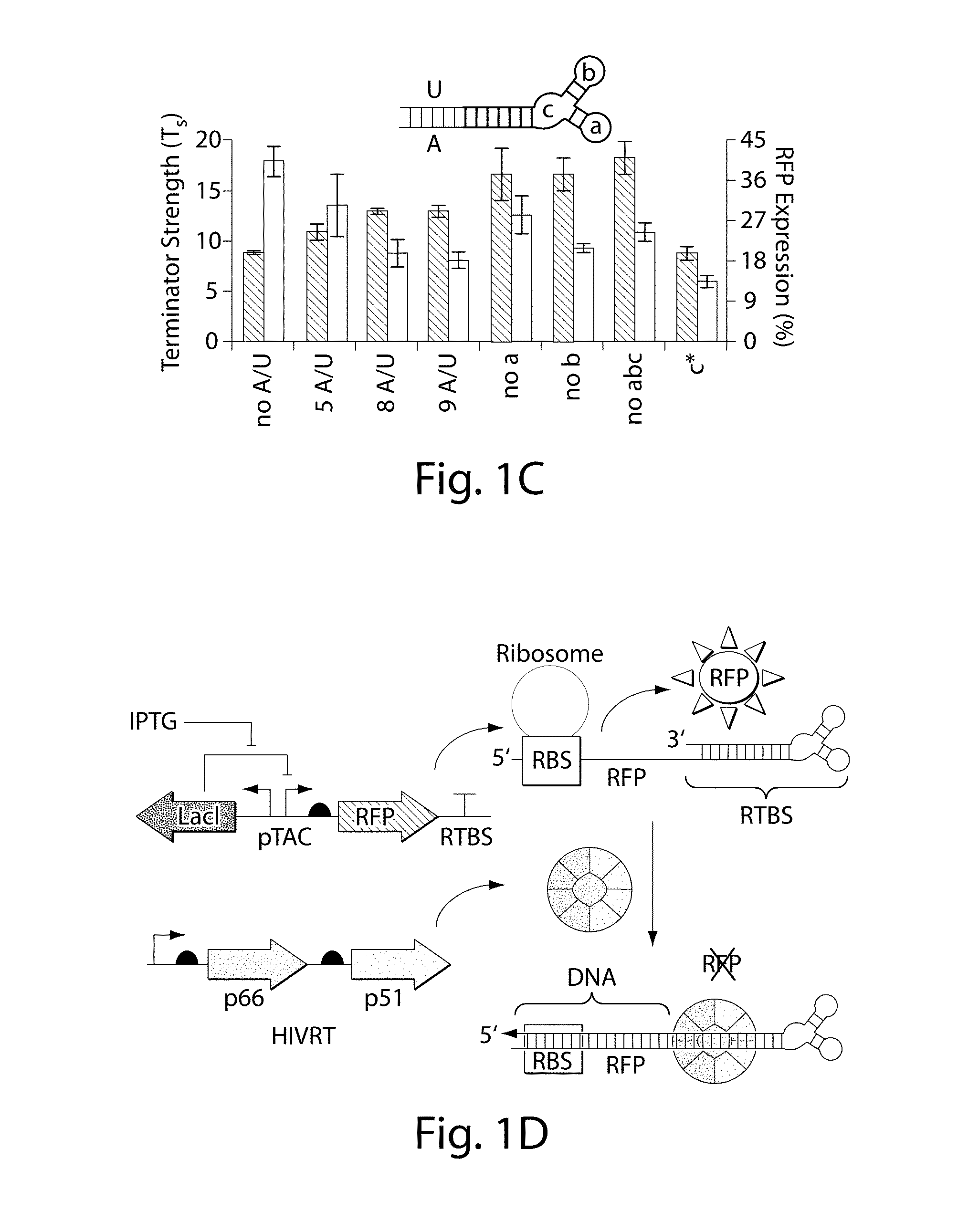Engineering DNA assembly in vivo and methods of making and using the reverse transcriptase technology
a technology of reverse transcriptase and dna assembly, which is applied in the field of engineering dna assembly in vivo and methods of making and using the reverse transcriptase technology, can solve the problems of limiting industrial applications, the possibility of producing nanostructures requiring long ssdna (>100 bases) and the cost of high-scale elements to genera
- Summary
- Abstract
- Description
- Claims
- Application Information
AI Technical Summary
Benefits of technology
Problems solved by technology
Method used
Image
Examples
example 1
Materials and Methods
Strains and Media
[0069]Escherichia coli strain DH10β (MC1061 F-endA1 recA1 galE15 galK16 nupG rpsL ΔlacX74 Φ80lacZΔM15 araD139 Δ(ara,leu)7697 mcrA Δ(mrr-hsdRMS-mcrBC) λ-) was used for all manipulations and assays except in terminator calculator measurement where DH5α (fhuA2 lac(del)U169 phoA glnV44 Φ80′ lacZ(del)M15 gyrA96 recA1 relA1 endA1 thi-1 hsdR17) was used. Cells were grown in LB Miller Broth or Super Optimal Broth (SOB). Ampicillin (100 μg / ml, Affymetrix cat. #11259 5), kanamycin (50 μg / ml, Gold Bio cat. #K-120-5) and / or Spectinomycin (100 μg / ml, MP Biomedicals cat. #021 5899305) were used where appropriate. Isopropyl β-D-1-thiogalactopyranoside (IPTG, Roche cat. #10 745 740 001) or L-arabinose (L-ara, USB Corporation #5328 37 0) inducers were used as inducers for the various constructs. Blue-white screening of colonies resulting from DNA assembly reactions was performed on LB-agar plates (1.5% Bacto agar; VWR cat. #90000-760) supplemented with 0.15 mM I...
example 2
Mechanism and Identification of the Reverse Transcriptase
[0081]FIG. 1F illustrates the synthetically-engineered pathway for the generation of ssDNA in E. coli. The construct consists of two main parts: the reverse transcriptase and a non-coding RNA (ncRNA) used as the template for the RT process. One of the reverse transcriptase used in the system is the HIV reverse transcriptase. The HIV reverse transcriptase is a heterodimer consisting of the p66 and p51 subunits.45 The p66 includes two parts, the N-terminal polymerase domain (440 residues) containing three subdomains (the finger, the palm and the thumb) and the C-terminal RNase H domain (120 residues). The p66 includes another subdomain (the connection) connecting the hand of the polymerase and the RNase H. This structural motif provides flexibility within this enzyme and facilitates the switching between its various enzymatic activities.46 The p51 subunit (450 residues) was created by a post-translational modification where the ...
example 3
Programming Assembly of DNA Nanostructure in Bacteria
[0083]By demonstrating the ability to synthesize ssDNA in-vivo, the study was extended to engineer cells to program self-assembly of DNA nanostructures, (FIGS. 2A, 17 and 19). The engineered-nanostructure is based on the assembly of four ssDNAs (each 40 bases) to form double crossover branched motifs. This is enabled by reverse transcribing four ssDNAs trough the RTs paradigm. In order to prevent the production of undesirable structures, two mainly rules have been implemented into the genetic circuits: (1) similar promoter strength for the transcription of the ncRNAs have been added to prevent effects of stoichiometric DNA assembly; (2)) the r_oligo parts are cloned antiparallel and an additional terminator to the RTBS has been added to these parts in order to increase their termination and to prevent the generation of very long DNAs. In order to prove the assembly process, the HIV-RT was engineered to be regulated under an induci...
PUM
| Property | Measurement | Unit |
|---|---|---|
| Length | aaaaa | aaaaa |
| Structure | aaaaa | aaaaa |
| Gene expression profile | aaaaa | aaaaa |
Abstract
Description
Claims
Application Information
 Login to View More
Login to View More - R&D
- Intellectual Property
- Life Sciences
- Materials
- Tech Scout
- Unparalleled Data Quality
- Higher Quality Content
- 60% Fewer Hallucinations
Browse by: Latest US Patents, China's latest patents, Technical Efficacy Thesaurus, Application Domain, Technology Topic, Popular Technical Reports.
© 2025 PatSnap. All rights reserved.Legal|Privacy policy|Modern Slavery Act Transparency Statement|Sitemap|About US| Contact US: help@patsnap.com



